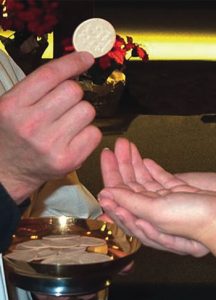Communion in the Hand

Fr Merv Duffy SM
In the period after the second Vatican Council there were many changes in the celebration of the Mass, including: the use of English rather than Latin, the dialogue mass with the people responding to the words of the priest, the sign of peace, and the possibility of communion under both kinds. At that time there was a call by a number of bishops’ conferences and liturgists for the reception of communion in the hand. As the Congregation of Divine Worship described it “in recent years a fuller sharing in the eucharistic celebration through sacramental communion has here and there evoked the desire to return to the ancient usage of depositing the eucharistic bread in the hand of the communicant, he himself then communicating, placing it in his mouth.”
The reference to “ancient usage” was the result of historical and liturgical studies that had found evidence of this practice in the early church. For example, in the fourth century, when instructing those to be brought into the Church at Easter, Bishop Cyril of Jerusalem wrote:

So when you approach do not come with your wrists extended or your fingers parted. Make your left hand a throne for your right, which is about to receive the King, and receive Christ’s body in the hollow of your hand, replying ‘Amen’. Before you consume it, carefully bless your eyes with the touch of the holy body, watching not to lose any part of it; for if you do lose any of it, it is as it were part of your own body that is being lost. Tell me, if someone gave you some golden filings wouldn’t you keep them safe and take care not to incur a loss through mislaying any of them? So shouldn’t you take much greater care not to drop any crumbs of what is more precious than gold or gems?
In 1969 the Congregation of Divine Worship surveyed Bishops throughout the world and discovered that two-thirds of them opposed the introduction of communion in the hand and a third were in favour of it. Their decision was not to change the traditional practice for the universal Church, but to allow national churches who asked for the exception the option for communicants to receive in the hand. Receiving communion in the hand was permitted in different parts of the Catholic Church at differing times. The option is still not available in some countries.
Make your left hand a throne for your right, which is about the receive the King
The New Zealand Catholic Bishops’ Conference requested that permission and were granted it on 24 April 1974. A programme of instruction and preparation followed, with the practice being introduced in mid-1975. My recollection is that this was done well in the parishes of New Zealand and most communicants adopted the newly available option. Around the same time, the introduction of the practice of receiving communion standing, and the removal of altar rails from most churches, encouraged the reception of communion in the hand.
The New Zealand General Instruction of the Roman Missal (2010) describes the present arrangements:
It is not permitted for the faithful to take the consecrated Bread or the sacred chalice by themselves and, still less, to hand them on from one to another among themselves. In the dioceses of New Zealand, standing is the most common posture for receiving Holy Communion, though individual members of the faithful may choose to receive Communion while kneeling.
When approaching to receive Holy Communion, the faithful bow in reverence of the Sacrament that they are to receive.
If Communion is given only under the species of bread, the Priest raises the host slightly and shows it to each, saying, The Body of Christ. The communicant replies, Amen, and receives the Sacrament either on the tongue or, where this is allowed, in the hand, the choice lying with the communicant. As soon as the communicant receives the host, he or she consumes the whole of it.
The consistent concern of the bishops has been that the presence of Christ in the sacrament of the Eucharist be recognized and reverenced. Part of the dynamic of liturgy is doing things together in the same way, such as standing for the proclamation of the Gospel. This desire for unity needs to be balanced against a respect for the freedom and choices of the individual. The General Instruction is clear that, where the option for receiving communion on the hand is available, the choice of how to receive the sacrament lies with the communicant.
 Entries(RSS)
Entries(RSS)